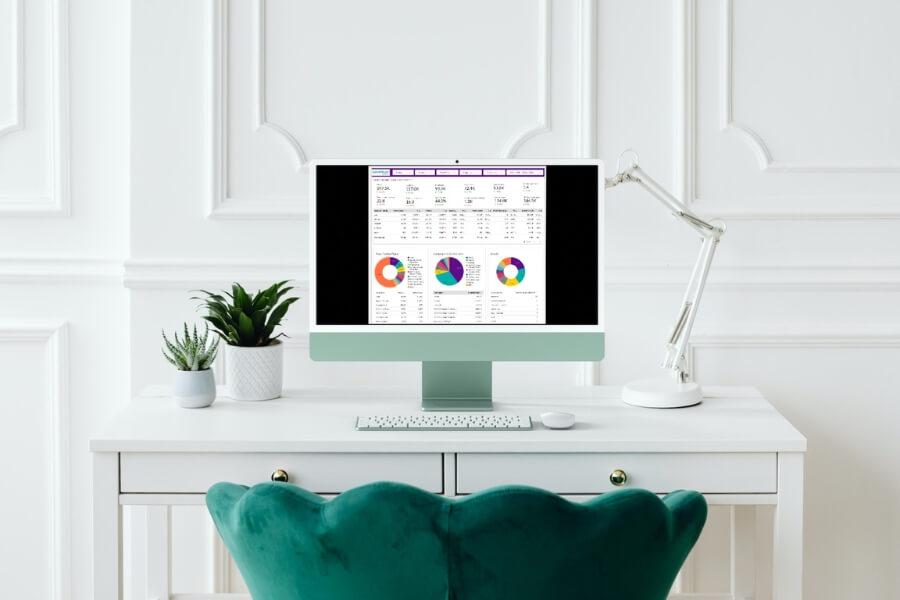Does your business have a digital strategy? What resources are you currently dedicating to your digital ecosystem? How much money is it generating for your business?
How is it creating, converting and growing your lead base?
Think beyond your website. Collect all of your digital elements — both customer and staff facing — together. This is your Digital Ecosystem. Ask yourself, ‘do all of the seperate elements of my Digital Ecosystem work together to add true value to my bottom line?’
So do they? How much value does it generate your business?
Not 100% sure? Then you need a Digital Strategy.
Welcome to digital fragmentation
Can you answer these questions?
- How do your business goals translate as a plan for success in the digital space? (Again, this isn’t just about your website . It’s not even just about your marketing effort — it’s any and every digital solution you run in your business and how they work together that’s important here.)
- Is your presence and activity on Facebook, Instagram, Twitter and LinkedIn supporting your business objectives and bringing you closer to your goals with every post?
- Is your website?
- How is your intranet, CRM, or business management software taking you closer to your goals?
- How are you measuring that?
- And the big one — how do they all work together?
The truth is, most organisations can’t answer these questions. They have a fragmented approach to their digital activities.
They’re siloed. They have never considered how their intranet or business management software can actually drive the customer experience and conversion rate in the virtual and physical marketplace. Or how CRM and Social Media can contribute to the organisation’s financial performance.
Fragmentation = opportunity
Digital fragmentation is not a bad place to be. It’s an opportunity for significant growth for your organisation, a place to start uncovering efficiencies and taking bigger strides in the right direction.
The centre pivot of your digital success is your Digital Strategy. And it’s exciting!
A true Digital Strategy acts as a roadmap or blueprint for action toward your long-term goals in the short — medium term. Why short to medium? Digital opportunities change so frequently, your strategy will likely be fluid. A good Digital Strategy gives you the power to be agile, while also not being distracted by every bright shiny new thing that comes up long the way.
A Digital Strategy should essentially map out your big, audacious business goals against digital objectives.
If your goal is to increase your membership to 50% 25–25 year olds, what does that mean for your digital ecosystem?
You might focus your attention on digital marketing, really understand which platforms your customers in that demographic are using, and start talking to them there. Maybe your goal is to improve the happiness score from your team’s last survey. In this case you’ll be thinking about intranets, internal emails, how your culture is represented on your website and LinkedIn, and other internal communication platforms.
The importance of having a Digital Strategy, over digital fragmentation, is why we like to start our major projects and partnerships with a phase of Discovery — an intensive research period to make sure all parties have their ducks in a row.
Yes, any business can plan their own digital strategy. But, with each businesses’ digital ecosystem expanding daily, it doesn’t hurt to call in an expert before that growth gets out of hand.
We’re experts at developing, executing and supporting these for our clients, with real outcomes.
We can show you through a number of case studies where we’ve helped clients accelerate towards their objectives as a result of developing and executing a Digital Strategy with them.
It doesn’t matter how big or small your business and ambitions are, sit down with us and let’s get your Digital Strategy in place and working hard for your business. So you can see real results!
Are you ready to begin the next phase of your digital success? Get started by understanding your digital ecosystem, and the four facets you need to pay attention to in order to see results.
Why doesn’t my digital strategy work?
One of the challenges with executing a Digital Strategy is that the sands are forever shifting.
Our consumers are forever evolving, growing in knowledge, tech savvy and consumption smarts.
So many times we start off on our merry path of what we think our business should achieve, and who we think our customers are, without actually validating our information, and we discover that our Digital Strategy actually didn’t work — we’ve made no money and we’ve invested all these resources for nothing.
We lose heart and confidence – and believe that the digital world is too hard, and we can’t conquer it.
WRONG!
You can build a digital strategy that works
A good digital strategy interrupts your customers.
It makes them think and behave in a different way.
But you’ve got to be thoughtful and process based. You also have to have clear, measurable goals against which you validate the worthiness of your activities.
That way, you won’t be swayed by “the latest and greatest” — but you’ll still have space to be agile and move in the same direction as your customers.
You’ve got to be persistent and committed to the methodologies and tactics. Unlike traditional media where you can set and forget, you do need to stay engaged and in tune with your plan, amending it as you need to ensure you’re engaging with your customers in the right place, at the right time.
We know how it feels to miss the mark and not achieve what you thought you were going to via your Digital Strategy.
But we can honestly say, through the failures, that there are a handful of essential tips we can offer to help get you on the right path to Digital Strategy success…
- Know exactly who your customers are, what their motivations and barriers to transacting are. Know where they live in the Digital World — what social platforms and product influencing sites e.g. Reddit, Productreviews.com they are frequenting
- Have clear goals for your revenue streams, and marry them with your various customer segments.
- Have a Content Marketing Plan and make sure that content converts. Content is your number one asset across all of your Digital Ecosystem, and you must have a plan!
- Build a Tactical Plan for each revenue stream and each customer segment — that’s so you know exactly what you are publishing, in which channel, when and where those customers are being redirected to, in order to complete the transaction process.
- Analyse where your customers are dropping off in the sales funnel, adjust your messaging or implement a new tactic to re-capture them.
- Ensure that you understand how to adapt your voice, messaging and call to action across the different platforms to engage with your customer segments correctly — refer to your Content Marketing Plan!
- Have a Brand Strategy! Your brand has to be the umbrella to your activities.
Our partnerships are based on uncovering, creating and implementing a great digital strategy for your business.
How to build a digital strategy in four steps
We talk a lot about strategy, and for good reason. Without a strategy, you have no focus, no plan, no goal posts, no measure of success.
Our Digital Success Partnerships (DSPs) are built with strategy in mind, but we were missing one piece of the puzzle: the internal strategy for successfully planning, implementing and measuring each client’s digital strategy!
1. Complete the Digital Business Model Canvas
We start top-level. Think about your business objectives, your customers, what partners you could share content with, what channels you currently use, and what kind of resources you realistically have.
To do this, we complete the Digital Business Model Canvas.
This is a thought-exercise to get you started — it doesn’t result in a strategy by itself, but it makes you think about some important things!
2. Assess your Ecosystem
Everything your business does online fits somewhere within your Digital Ecosystem, and before you can plan for the future, you need to know what its current status is.
Read more about the Digital Ecosystem and download a copy of the visual framework.
Action 1: Print out the Ecosystem framework and tick off what you have and what you think you need.
Step two in assessing your current status is recording some baseline metrics. You should write down how each element in your Ecosystem is currently performing, so you know when you’ve improved and by how much.
When we do this audit for our clients, we have an extensive list of standard metrics to record. For your audit, visit the tracking or “analytics” area for each element (if it exists), and export a report for the past 30 days or just write down some of the key numbers.
Action 2: Record the key metrics for the past 30 days for each Ecosystem element.
3. Write your strategy
At this stage, we run a Discovery Workshop with most of our clients where we go through the Canvas and Ecosystem Audit and our strategic recommendations. The result is a document with a Strategy and Tactics for achieving the goals of each Ecosystem element
For each element, we document its:
1. Objectives
Why do we have this element? What general things are we trying to achieve with it?
2. Activities
What steps are necessary to achieve these objectives? What do we need to plan, design, build, set up, research, document, kick off etc.? Who will do them?
3. Goals & KPIs
How will we know when we’ve succeeded? Make your goals S.M.A.R.T.! What specific metrics or KPIs will we look at to measure the goal?
It might seem like a simple structure, but the content in this document can be invaluable.
So how does a small business figure all this out by themselves?
The short answer is, that you just might not be able to do it all. But you can and should try it!
Every business should be able to define their objectives for each element in their Ecosystem. It helps to have an understanding of the general audience and best practices of a medium to understand how to best use it, but that shouldn’t stop you from setting some objectives, even if you later on discover that they need to change.
You can also decide on some sort of activities for each element, even if it’s just “Source somebody to build this for us”! You should be able to set up and get started with most of the elements in the the Social Media and Content Marketing facets, at least.
Once you’ve worked out what you can take on yourself, then you have a good scope for hiring someone to help fill in the gaps.
Setting goals for each element is really important. It helps to have a strong understanding of what metrics are available and what they really mean, so you can tie them back to your business objectives. Make sure that your chosen metrics mean that you’re becoming known, building fans, gaining leads and making sales. If a particular number doesn’t imply growth in any of these areas, it’s probably not worthy as a goal.
Action: Write down each Ecosystem element that you currently have or plan to implement. Define your objectives (why), activities to undertake (what) and goals (measure of success).
4. Set your 12 month Roadmap
We’re in the process of building a Partnership Roadmap with each of our Digital Service Plan clients, which defines the projects we’ll be working on, ongoing work each of us will do, and when meetings, reports and audits are due.
Once you have a list of activities to start on, you can make one for yourself. Make it eye catching and easy to read, then print it out and put it somewhere prominent where you and anyone else involved in bringing your strategy to life can see it every day.
What to include on your Roadmap:
General timeframes for each main piece of work.
eg. “Complete blog editorial calendar — end Feb 2016”
Ongoing work, with frequencies and responsibilities.
eg. “Monthly blog post — Write Tuesdays, Publish Fridays — Mary”
Regular reviews. Set aside times to check-in with how you’re progressing on your activities and against your goals.
These can be weekly, monthly or quarterly, and I recommend planning a different type of review for each of these timeframes.For example:
- “Every Monday — quick chat about last week and plan for this week”
- “First Thursday of each month — meeting to review what we’ve done, overview of metrics and make sure next month’s plan is still correct”
- “First Thursday of each quarter — sit down meeting to conduct monthly meeting in more detail”
Action: Create a simple table (in Word, or even Canva) to create your Roadmap. Complete it with the activities you’ve already decided on and have everyone involved commit to whatever regular reviews you put in the Roadmap. Print it out and put it up!
5. Stop, check, refine
This is where you set up some monitoring and conduct your reviews.
The digital environment and business in general are always changing (and at a fast pace). We always need to STOP. CHECK. REFINE our strategy, plans and activities. If things aren’t working, make changes until you get the results. Marketing is a moving beast and not all activities touch the customer’s “sweet spot” first time round. Use your analytics tools to help measure the activities KPIs.
You can monitor each element in your Ecosystem through their native analytics or “stats” area (eg. Facebook Insights) or use tools that collate reports for you.
Remember to focus on metrics that support your strategic goals (they mean something and you can take action from them).
Stop, to have your regular reviews (by yourself or with your team).
Check your KPIs, goals and if you achieved all your planned activities.
Refine your plan for the next period of time. Update your planned activities and consider if you should change your KPIs or strategy.
Take the plunge
Yes, doing all of this takes even longer than this blog post takes to read, but it’s worth it. (We are here to help!)
Without thinking strategically, considering your audience, setting goals and reviewing your progress regularly, you’ll continue to muddle along online without knowing if you’re getting any real return on investment.
Any business should be able to attempt each step I’ve recommended themselves, but if it’s a bit overwhelming, you don’t have time, or you’re just after a professional’s touch, we would love to talk to you about your Digital Strategy.



